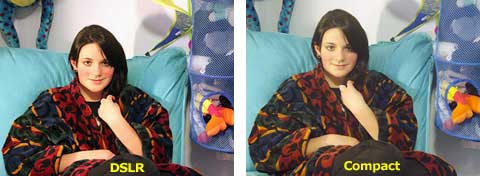2008: Last month we looked at the megapixel myth. As we noted then, “in the rush to market megapixels, images can actually be worse with a high megapixel camera than from a lower megapixel one.” The sad truth is that it’s worse than we thought.
Mason Resnick of Adorama has exposed another issue caused by an unhealthy fixation on megapixels: As compact digicams include more and more megapixels on their tiny sensors, something has to give. In Stop the Megapixel Madness!, he says,
“…each pixel has its own microscopic lens, and each lens is separated by a microns-wide wall, or septum, to prevent light from falling from one pixel into the next and thereby reducing image quality . . . to make room for eight, nine, or (heaven help us, again) ten million pixels, those septums get either unusably thin, or are removed altogether.”
The result of removing the septum? Spillover from one pixel another, which can cause fuzziness and increase noise (the digital equivalent of film grain).
As we’ve said before, 3 megapixels is all you need for a great 5 x 7, and most people can’t tell the difference between an 8 x 10 from a 3 MP image or a 6 MP one. A 6 MP digital will easily give you a 12 x18 print that looks very sharp indeed.
So why the fixation on megapixels? It’s not quality, it’s marketing. If 3 MP is better than 1.3 MP, and 6 MP is better than 4 MP, then 12 MP must be even better.
While it’s true that more megapixels means better images that can be printed even larger on digital single lens reflex (DSLR) cameras, that’s not always the case with compact digital cameras. Beyond a certain point, the small image sensors with their increasingly small individual pixels get small enough that digital noise becomes a significant factor. Your photos may have more pixels, but they are also likely to have a lot more “grain”.
Make the pixels small enough, and the septum (the dividers between the individual sensors) – no matter how thin you make it – ends up cutting off some light, further increasing noise. The solution? For some manufacturers, it means removing the septum, which means that light can spill over to adjacent pixels.
The result of that is a lower contrast, noisier, fuzzier image, as Adorama clearly shows on its website. Too many megapixels in a compact digicam can mean worse images, not the better ones you would expect based on their megapixel rating. And none of the manufacturers are going to make a point of telling you if they don’t have a septum on their image sensor.
Don’t believe it? Check out the comparison images that Adorama has posted (reduced even further below). Even when greatly reduced to 0.15 MP for use on the Web, those shot with an 8 MP DSLR look gorgeous, as everyone would expect. Those shot with an 8 MP compact camera look horrid: low contrast, washed out colors, more noise, and blurring of details. And there’s nothing you can do in Photoshop to fix those problems.
You can, however, make matters even worse by shooting at a higher ISO setting. Again, it’s something DSLRs can do well with their larger sensors, but as far as compacts go, it’s going to further increase noise and graininess in your images.

Comparison of 8 MP DSLR and 8 MP compact (reduced from Adorama website)
As Resnick notes, “You may be able to make big blow-ups with your 12 MP compact, but they won’t look as good as manufacturers want you to believe.”
Don’t buy a camera based on specs alone. All image sensors are not created equal. All lenses are not created equal. And all 8 MP images are not created equal – and 8 MP may be more than you need. Kudos to Adorama, a camera retailer, for pointing out the truth.
Look at the images the camera creates. That’s the true test, not the number of megapixels in its images.

